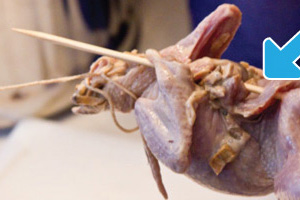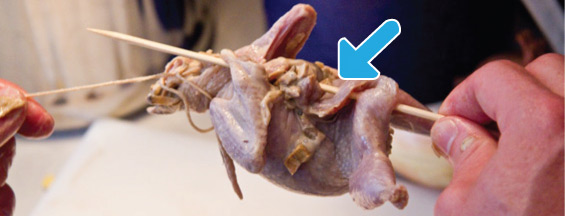Butcher’s twine is the ideal tool for tying meats prior to cooking. But if you are like us you never seem to have it on hand. Here’s what we have used in a pinch:
Sinew – Sinew has been used in bowstrings and tying applications since ancient civilizations first came up with the idea…why not food? Almost anything made from a natural fiber that won’t melt will work. We literally pulled it out of the crafts section. It worked fine.
Dental Floss – yes…dental floss. Don’t use flavored, waxed or plastic varieties, and though it works surprisingly well (and was designed to be put in your mouth), it really should only be used as a last resort. Do be very sure to take it off the food prior to serving, or your guests will be seriously creeped out.
This pancetta-barded kangaroo rack recipe? Dental floss.

Cotton String – the closest thing to butcher’s twine, but it can leave threads in your food. Try to use the tightest-wound, thinnest string you can find. Don’t use any string that you can’t be sure is food safe…for example, nothing that has been stored somewhere unsanitary, dyed with chemical dyes that might bleed into your food, or used with projects involving any sort of chemicals, paints, etc.
This wild boar we’re tying? Cotton string.

Wooden Skewers – Small cavities can be stitched closed using wooden skewers…a technique commonly used for pounded chicken dishes like chicken Cordon Bleu.




Comments 1
If bacon was a little stronger, you could tie it up with bacon. Bacon makes everything better.